Andrejs Šķesters Has Given His All to Research for 37 Years
On 15 November, Andrejs Šķesters, the Head of the Scientific Laboratory of Biochemistry and a senior researcher and Associate Professor of Rīga Stradiņš University (RSU), received the Certificate of Appreciation of the Ministry of Health from the Minister of Health Ilze Viņķele. He received this acknowledgement for his significant long-term contribution to research in the field of genetics and biomedicine.
Associate Professor Andrejs Šķesters has studied Pharmacy and received a PhD in Biology. Today Šķesters, together with his colleagues at RSU, is working on significant studies on cardiovascular diseases, type 2 diabetes, oral health etc. on both a Latvian and European level. The latest project of the Scientific Laboratory of Biochemistry is looking into selenium and thyroid disorders. The laboratory, which is located in the RSU Science Hub in Kleisti (5 Rātsupītes Iela), has become the leading laboratory of its field in Latvia and is also well known in Europe.
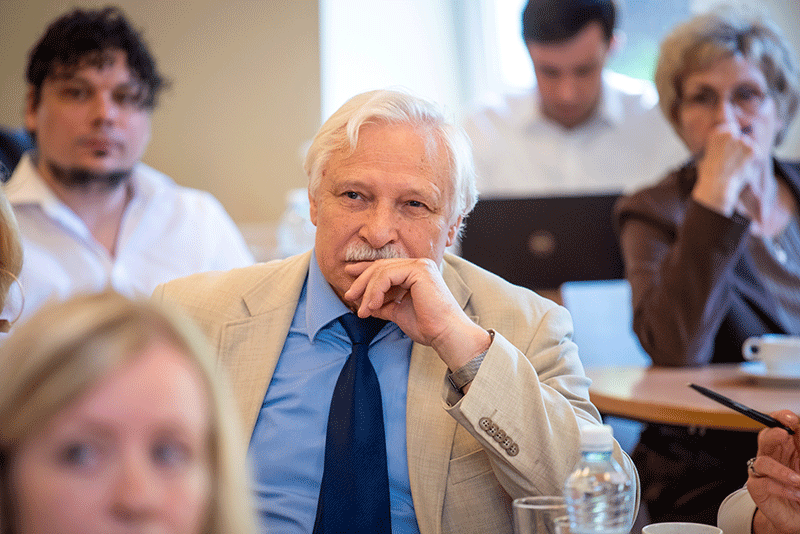
The laboratory has always been actively involved in research. This summer you completed your work on the M-era.Net project PELARGODONT and the results are going to be patented. Could you, please, tell me more about the project?
The Lithuanian University of Health Sciences (formerly the Kaunas Medical University) was the leading institution on the project. We represented Latvia together with the Laboratory of Pharmaceutical Pharmacology of the Latvian Institute of Organic Synthesis, led by RSU professor Maija Dambrova. Lithuania was represented by the company Ferentis, Poland – by the University of Krakow and the Center for Polymer and Carbon Materials Research, Polish Academy of Sciences, and Italy – by the University of Eastern Piedmont.
The project was related to oral health, namely the potential treatment of the severe oral disease periodontitis by using biologically active substances from the roots of the geranium plant, which is used in Latvian folk medicine and is colloquially called the “ear flower”.
Either natural phytopharmaceutical substances, biologically active root substances, or proanthocyanidins were excreted by the plant's root.
The Lithuanian and Polish teams created special sponges that were soaked in pelargonium root extract, or the proanthocyanidins, and applied to the gums and around the root of the diseased tooth. It was proven that as the sponge decomposed over time these biologically active substances were released, but under the pre-conditions that no toxic products created during this degradation products of these sponges should occur. The process took several months.
The Latvian researchers, meanwhile, evaluated the extent and speed of how the biologically active substances of this plant were being excreted from the sponge. The RSU Scientific Laboratory of Biochemistry was in charge of everything related to the inflammatory biomarkers. In other words, all inflammations cause oxidative stress, and we investigated what levels of that stress could be found in saliva and how the body can reduce inflammation during prolonged exposure to the plant’s biologically active substances, which in turn reduces the amount of stress markers in saliva. It was a challenge for us, since we had not worked with saliva in the laboratory before.
The study lasted two years and its outcome was positive enough to allow us to try patenting this new therapeutic technology.
Was it the Latvian researchers’ idea to use geraniums for oral health?
We started collaborating with our colleagues from the Lithuanian University of Health Sciences more than five years ago when we worked together on the Eureka Antioxidiabetes project. In the two-year project patients with chronic type 2 diabetes mellitus, who had already suffered serious organ and vascular damage, were treated with biologically active supplements, like ginkgo biloba leaves and green tea mono-extracts, in combination with traditional medication. These extracts were enriched with garlic extract. At the time it was a supplement produced by the company Grindeks. We investigated the effect of these various extracts on the development of secondary pathologies in patients with type 2 diabetes.
Untreated type 2 diabetes causes changes to the internal environment of a patient's body and increases the amount of free radicals, which further provokes and aggravates the appearance and development of secondary pathologies in the eyes, nerves, kidneys and the cardiovascular system. We were well aware that these supplements could not cure type 2 diabetes mellitus, but we hoped that they could reduce the formation and flow of free radicals, therefore prolonging a patient’s capacity to work and sustain quality of life for longer.
After the two-year study, during which patients had been using these biologically active supplements, the doctors established that the health of the patients had not deteriorated in any considerable way. Whereas the biochemical measurements undertaken by us demonstrated that we had succeeded in reducing the amount of oxidative stress markers and improving antioxidant protections in the body.
Several local and international publications wrote about the results of this study and, although this was a long time ago, statistics reveal that new readers still find these articles weekly.
This project was a stepping stone to further collaboration with the Lithuanian University of Health Sciences as we stayed in touch and at some point a semi-joke about working on the healing properties of geraniums ended up a successful project.
What kind of research are you currently involved in?
Professor Ilze Konrāde got the opportunity from a project competition by the Latvian Research Council to implement a very interesting project together with us at the end of 2018. The project was related to changes in the selenium content in the body, which is one of my first passions in science. Eventually, the project was approved and has been granted 200 000 EUR in funding.
The study deals with potential non-conformities in selenium concentration, like when selenium is deficient or excessive, which can affect thyroid function and hormone formation leading to various diseases such as Graves' disease or Hashimoto's syndrome.
We have thrown ourselves into this work emergetically. The first test results with which we will try to investigate and understand the metabolism of selenium are coming in to our laboratory. We will use these to both look at the selenium concentration in the body, and the activity of selenium protein and selenium-dependent glutathione peroxidase. I would like to note that glutathione peroxidase is one of the most important enzymes that neutralises free radicals. The purpose of the study is to understand the extent to which selenium might be decisive in the normalisation process and how it affects thyroid function and hormone systems.
We recently participated in a Latvian Research Council project competition together with the Dobele Institute of Horticulture at the Latvian University of Life Sciences and the Department of Internal Diseases at RSU. The concept of this project was to prescribe viburnum extract to patients with high blood pressure and combine this with basic therapy. Unfortunately, our idea was not accepted.
Was becoming a researcher an inadvertent or deliberate choice?
A bit of both. I have worked for 50 years, 37 of which have been devoted to RSU. At first, I underwent training to become a pharmacist and worked at a pharmacy for two years. Then I stepped away from medicine for a bit and graduated from the Latvian Academy of Sports Education. After this I worked at what is now the University of Liepāja for several years where I supervised their medicine-related studies. In hindsight these formed the origins of the Faculty of Rehabilitation – you could study to become a speech therapist, or a therapeutic physical education methodologist, for example. Years passed and I was invited back to Riga. In 1983, the Laboratory of Functional Myocardial Biochemistry at the Riga Medical Institute (the precursor to RSU) was hiring a senior laboratory assistant “with brains and the ability to work with their hands". Back then the head of the laboratory was a very vibrant personality – Estonian Leili Utno. I slowly rose through the ranks and started on my doctoral studies. It took years until I obtained my PhD in Biology.
Starting to work in the laboratory was exciting! I was assigned to participate in children’s heart surgeries where I had to draw blood at the right moment both from the artificial circulation machine and the patient. The main authority was Professor Jānis Volkolakovs who was assisted by Professor Aris Lācis, surgeon Augusts Ozols, anaesthesiologist Juris Vaters and nurse Alma. I felt more comfortable with anaesthesiologists as they were less “cocky". Ours was one of the largest centres in the USSR, where children with severe heart disorders from the northern part of the Soviet Union were sent for operations. The purpose of our study was to find out how to protect cell membranes during deep hypothermia, when returning to normothermia as well as during circulation by the operated heart. This clinical study and the cardiac ischemia-reperfusion model provided the basis for my doctoral thesis. I defended my doctoral degree in 1998.
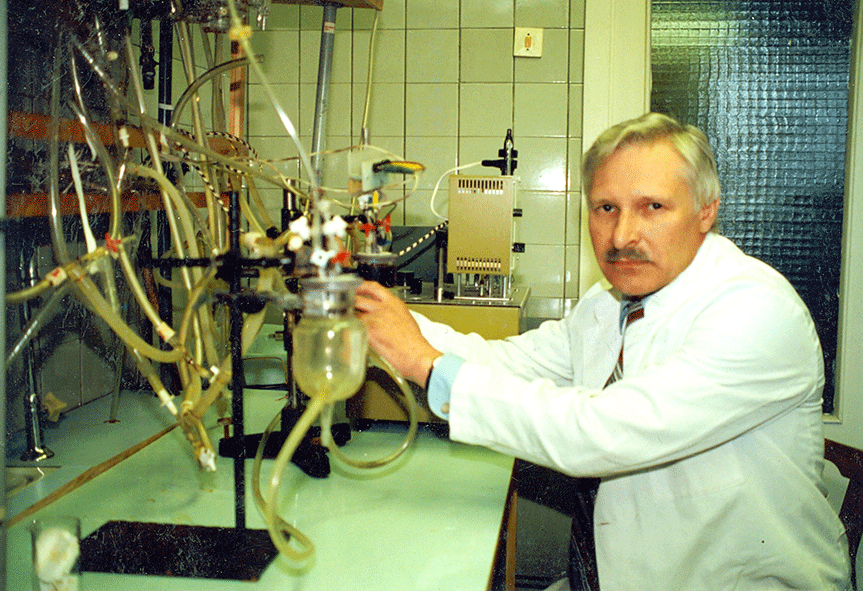
Andrejs Šķesters in 1984 at the Laboratory of Functional Myocardial Biochemistry of the Riga Medical Institute, which was at the time part of the Department of Medical Biochemistry. He created this model of cardiac ischemia-reperfusion himself. Photo from the RSU Museum archive.
Which of the people that you have met along the way would you say taught or inspired you in your research?
Many people have had a great impact on both my life and the development of the laboratory: first of all, there is Leili Utno; Professor Vladislavs Korzāns; then the Rector of the Riga Medical Institute, Professor Arnolds Valtneris; and later Manfreds Anke from the University of Jena in Germany who was once the head of the micronutrient department at the German Academy of Sciences and in the 1990s opened the door to Europe for my laboratory.
And that was only the beginning! Later Greece, Hungary, England and other countries joined Germany to become our project and research partners.
Some of the first were Serge and Sophia Polet from the University of Athens, then Mihaly Szilagyi from the Hungarian Academy of Sciences. Kim D. Rainsford from Sheffield Hallam University, and Brian Callingham from Queens' College at Cambridge University have collaborated with us on a number of studies concerning the health of the first responders cleaning up after the Chernobyl nuclear disaster, as well as on several publications. These are just a few examples of people with whom I have worked and spent time together.
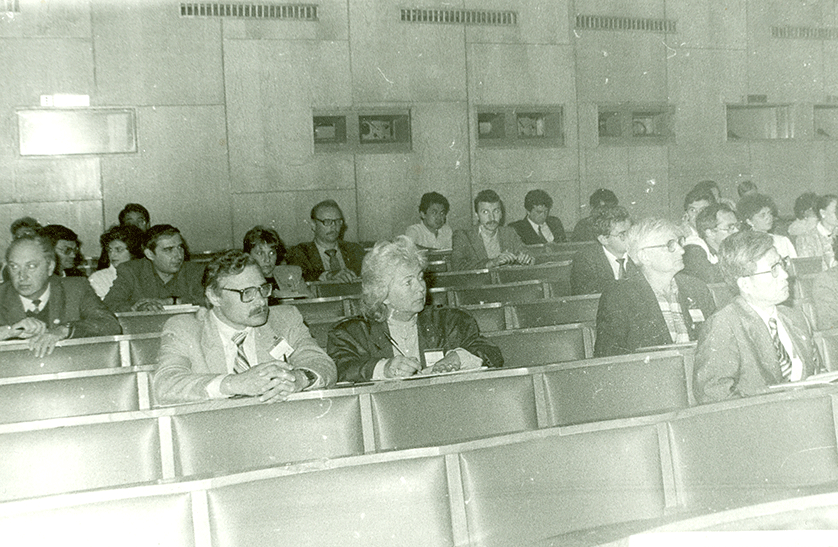
Centre – Andrejs Šķesters wearing glasses, and on his right – Leili Utno, the Head of the Laboratory of Functional Myocardial Biochemistry of the Riga Medical Institute. ‘My farthest trip during the Soviet era was to Varna in Bulgaria in 1989. A joint seminar for the Soviet and the Bulgarian Academy of Sciences was held there in Russian,’ Andrejs Šķesters remembers. Photo from the RSU Museum archive.
What distinguishes a good researcher from an average one?
I think that many factors can affect results, both personal and others such as the team someone is working with, the technical capabilities of the research structure, as well as the type of projects and funding you receive.
How do you try to attract students to research?
Students, especially the exceptional ones, are busy with their studies. I cannot make my colleagues at the laboratory work extra shifts in order to wait for students who want to come to the laboratory in the evenings after their studies. If we were a larger laboratory with more staff, we could arrange for one colleague to work in the morning and another in the evening.
We try to help our students as much as we can. Particularly thanks to the PhD student working with us part-time in the evenings, we can also take a student under our supervision.
Younger colleagues from the Faculty of Rehabilitation’s Nutrition programme often come to us to work on their scientific research papers.
It will be Christmas soon... How do you celebrate winter solstice?
We celebrated Christmas at our laboratory during the Soviet era as well. Our laboratory was to a certain extent subordinated to Rector Vladislavs Korzāns, and we had a very convincing Head, Leili Utno. If nothing else, we attended cultural events or went to the Museum of Art or History at Christmas. In any case, we have never worked on Christmas Day, not even during the Soviet era.
At home, we have a Christmas tree and presents, and we attend our local church in Torņakalns...
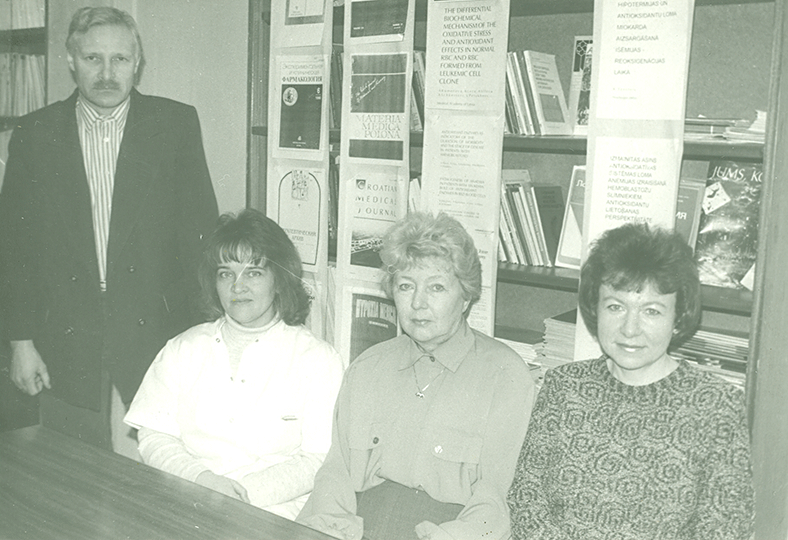
In the late 1990s at the Laboratory of Functional Myocardial Biochemistry of the Riga Medical Institute. From the left: Andrejs Šķesters, Anna Lece, who defended her doctoral dissertation ‘with us’, Head of the laboratory Ausma Kumerova, and the current leading researcher of the Scientific Laboratory of Biochemistry of RSU, Alise Silova. Photo from the RSU Museum archive.
Next year marks the 70th anniversary of RSU. How would you like to celebrate?
It would be great to meet all of the people who are still here, and in my thoughts converse with those who are no longer with us.
What do you wish for your university?
Not to be caught up in messy politics, and to preserve the great things that we have! To think of the people who work here and to fight for them!
Of course, we would accomplish a lot if we managed to attract more funding. The road we are on is, in my opinion, a very good one – we are developing and moving towards a certain scientific concentration... The University needs to continue following Ariadne's red thread and not deviate. Medical education must remain the priority for our alma mater.
A few facts about Andrejs Šķesters
- Head and Senior Researcher at the RSU Scientific Laboratory of Biochemistry,
- Scientific research dedicated to biomedicine,
- Obtained a PhD in Biology in 1998,
- Currently teaches the study courses ‘Free radicals in medicine and biology’ and ‘Cell metabolism under altered conditions’ at RSU,
- Four patent applications submitted and two approved over the last five years,
- 15 publications in both international and local journals and 18 conference theses written over the last five years,
- Supervisor of three doctoral theses, with two defended so far.
Related news
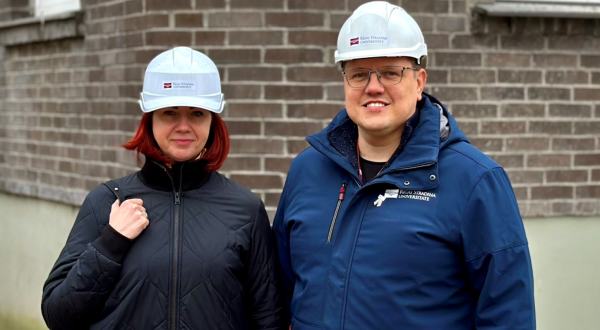 RSU is growing and developing: major reconstruction underway in the main buildingDevelopment, For RSU Employees, For Students
RSU is growing and developing: major reconstruction underway in the main buildingDevelopment, For RSU Employees, For Students


